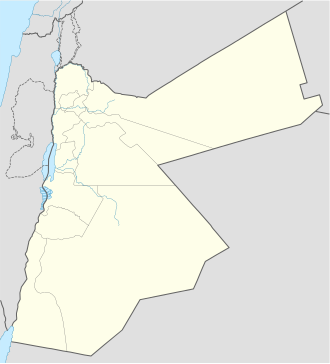Top Qs
Timeline
Chat
Perspective
Qasr Bshir
Ruined Roman fortress in Jordan From Wikipedia, the free encyclopedia
Remove ads
Qasr Bshir (Arabic: قصر بشير; Latin: Castra Praetorii Mobeni) is an ancient castrum (Roman fortification) in what is now Jordan. Isolated in an area of the desert rippled with shallow valleys that drain into the Wadi Mujib,[1] it is about 80 kilometres (50 mi) south of the capital city, Amman. The structure is not visible from any settlement or Jordan's Desert Highway.[2] It measures about 57 metres (187 ft) square and stands three storeys tall.[2] Qasr Bshir is one of the best-preserved examples of a castellum or small Roman fort,[3] and it retains its Latin inscription above the entrance.[4][6]
The castrum was part of the Limes Arabicus, a chain of forts and watchtowers on the eastern desert frontier of the Roman Empire.[7] Construction began in the late third century,[2] during the Tetrarchy, when the empire was divided between four emperors. Diocletian sought to secure Rome's far eastern border with a string of fortifications.[8]
The Limes Arabicus, or Arabian frontier, protected the Roman provinces of Syria and Arabia Petraea from raids by Arab nomads. Each location was just far enough apart to maintain communication.[8] Satellite imagery has since revealed many smaller outposts scattered to the east, indicating that Qasr Bshir was also likely part of a trade network stretching into Persia.[9] Although it is now located where the Syrian Desert meets the semi-arid steppe country in the Jordanian Highlands, the area once experienced higher rainfall and there is evidence of agriculture during classical antiquity.[2] By 500 CE, the eastern forts, including Qasr Bshir, were abandoned.[8] Centuries later, the site was reoccupied by the Umayyads until earthquakes in 747 and 749 destroyed much of the building.[10]
Since historians Rudolf Ernst Brünnow and Alfred von Domaszewski began documenting the site in the late nineteenth century, significant additional damage has appeared in the structure. Large cracks not visible in their original photographs have formed, and entire rooms have collapsed.[10] Extensive archaeological surveys were carried out during the 1980s.[11] To study how the Romans would have communicated with Betthorus over a dozen kilometres away, archaeologists manned outposts on the Limes in 1982, including Qasr Bshir and the nearby watchtower Qasr Abu el-Kharaq. They used smoke signals, mirrors, and torches to test how effectively messages could travel along the frontier, finding that, although winds could hinder smoke visibility, mirrors were visible within 5 kilometres (3.1 mi) during the day and torches were visible up to 10 kilometres (6.2 mi) at night.[12][13]
Qasr Bshir is listed on the Jordanian Tentative List as a potential World Heritage Site and may become one contingent upon measures to preserve it. Weathering and looting of stones continue to threaten the structure, and one tower, supported by a single remaining cornerstone, is in danger of collapse.[2]

Remove ads
References
Further reading
Wikiwand - on
Seamless Wikipedia browsing. On steroids.
Remove ads


